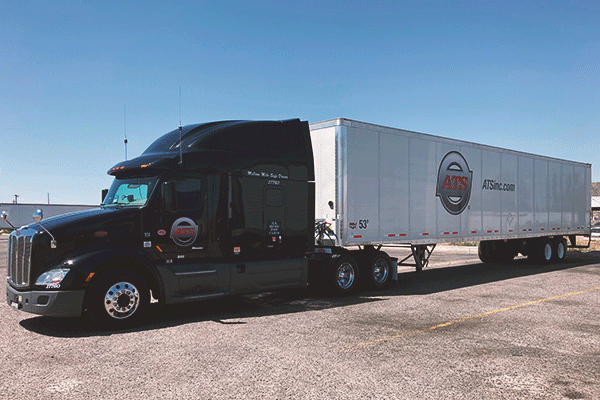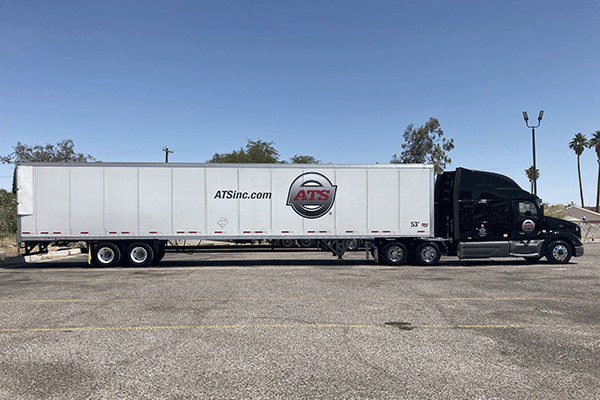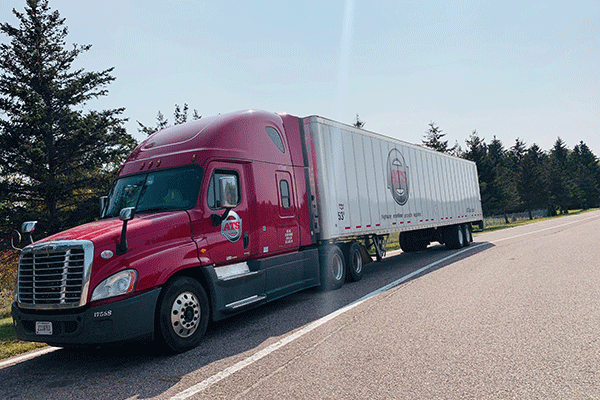
Every business cares about the freight they move, the shipments that keep their businesses running and the dollars rolling in. So yeah, it could be argued that every load is “highly valued” by the companies arranging its transport.
That said, the monetary value of each shipment fluctuates greatly between them. And, as a company that consistently moves high-value freight (that you highly value 😁) you’ve found that maintaining a budget on these loads can be really difficult — especially in recent history.
Here at Anderson Trucking Service, we’ve been in the transportation industry — and helping companies move high-value commodities — for more than six decades. During this time, we’ve seen firsthand how challenging it can be for the companies that move these cargoes to do so in a cost-effective manner.
Too often, in response to questions regarding why these price hikes happen or what they can do to avoid overpaying, logistics professionals are met with silence. If this sounds familiar, like a situation you’ve previously found yourself in, rest assured: Today, you’ll get the answers you deserve.
In this article, we’ll explain the two main reasons moving high-value freight costs more than other shipment types and give you three tactics for avoiding unnecessary price increases in the future. Let’s get to it.
What is Considered “High Value” Freight?
Phrases like “oh wow, that’s expensive!” are textbook examples of subjectivity.
For example, many people think paying anything more than $30 for a wristwatch — which technically can’t even be classified as a necessary “tool” in the digital age — is way too much money.
Other people would beg to differ, sighting “craftsmanship” and “fine-tuned mechanical mastery” as huge selling points of luxury watches. Personally, I tend to agree with the latter side of this argument, but that’s beside the point.
My point is this: What is considered “high value” to some, might not meet that mark for others.
Luckily, the transportation industry — and the companies within it — have set some clearly-defined thresholds distinguishing high-value shipments from those that are less so.
Typically, once your freight’s total cargo value surpasses $100,000 — an amount that many carriers don’t insure beyond — you’re navigating in “high-value” territory.
As your load’s total value edges past $100,000 and toward ranges of $250,000 - $500,000+ the cost of moving these commodities rises substantially with each tier.
Let’s talk about why.
What Makes High-Value Loads Cost More?
Circumventable risk of theft and damage accompanies all shipments — regardless of their value.
There’s always a chance, however slight, that something could go wrong in transit, causing damage to a product.
That said, the likelihood of this happening, coupled with the (relatively) minor cost of replacing/repairing cargoes valued below $100,000, leaves shippers — and transportation companies — with few worries.
At higher value points, however, this risk of theft and damage — no matter how minute — hits a bit harder.
Since these shipments are harder to repair and more expensive to replace, transporting products like consumer technologies, alcohol, cigarettes, highly-sensitive refrigerated freight and large machinery (to name a few) creates an aversion in many shippers.
This risk-aversion, and the added desire to safeguard their assets, forces shippers to pay more for transportation services for three primary reasons.
- The need for increased security measures.
- Higher cargo-coverage insurance requirements.
- Smaller pool of viable, qualified, transportation options.
1. The Need For Increased Security Measures
This first point applies, primarily, to high-theft commodities (such as technologies and other expensive retail goods). Some of these shipments — which hold a risk of theft that far exceeds that of other products — utilize security escort services to move them.
In these instances — when a shipper requests this additional avenue of protection — their freight rates rise. The cost of employing highly-skilled security personnel to accompany a shipment can be high. For this reason, unless absolutely necessary, the majority of businesses with high-value freight to move choose to venture away from doing so.
That said, should the nature of your freight necessitate escort services, plan to pay more to line a good company up.
A far more common security measure that shippers employ to circumvent the risk of in-transit theft is to work “stop risks” into their carrier contracts (where applicable). In doing so, these shippers can specify how frequently (or not) a shipment is allowed to stop during transit.
For example, instead of a trucker stopping within 500 miles of the pick-up location, businesses can request that they don’t. Or, should the situation call for it, it’s possible to request a continuous transit — with stops for refueling alone.
To meet these requirements, transportation companies often need to put a team of drivers on your load, allowing them to keep your freight moving at all times. That said, employing a team for your shipment will increase your price heavily as the number of truckers on your load doubles.

2. Higher Cargo-Coverage Insurance Requirements
It stands to reason that high-value cargoes would cost more to move; if it was easy and inexpensive to do, every trucker worth their salt would offer these services.
That said, qualifying themselves for these shipments takes a significant investment from each driver in the form of increased insurance premiums and training (where applicable).
Note: in recent years, due to the increased frequency of nuclear verdicts, insurance premiums have skyrocketed to match this increased risk.
For you, any additional investments made on your trucker’s part — increasing their cost of doing business — will trickle down to you. And, as the amount of cargo insurance your products require rises, so too do your provider’s insurance costs.
As such, expect to pay more to move your high-value cargoes because supplying this service and meeting the insurance levels required to do so is costly for trucking companies and their drivers.
3. Smaller Carrier Pool to Select From
The cost of moving your products, although influenced by many things, is directly tied to supply and demand in your load’s area. If the supply of transportation solutions surpasses market demand, spot rates — which dictate the current cost of transportation freight — fall.
Conversely, whenever the demand for truck space outpaces total supply, shippers with goods to move pay more to secure transportation capacities.
The high-value nature of your shipments creates an additional wrinkle in this process, though.
You see, as a load becomes more specialized and the criteria for hauling it rises from the norm, the pool of qualified carriers for shippers, like you, to select from dwindles.
For this reason, high-value shipments that require truck drivers to hold heightened levels of insurance can be difficult to find a trucker for.
Think about it:
If there are 100 dry van truck drivers ready, willing and able to haul loads in your area, your pool of options is pretty wide — increasing your bargaining power and decreasing your price.
Now let’s imagine that 80 of these truck drivers hold $100,000 of cargo coverage — the perfect amount for hauling the vast majority of standard freight shipments. As a shipper with cargo that falls beneath this ceiling — as most dry van commodities do — 80 truck drivers is plenty to choose from.
The remaining 20 truckers in your area hold extended amounts of cargo coverage. 15 of them are covered up to $250,000 while the remaining five are insured up to $500,000.
Assuming that your shipment’s listed value falls somewhere within these thresholds, your options for moving it are limited to this minuscule pool of qualified truckers.
Granted, the list of shippers interested in procuring a solution that boasts $250,000 of cargo insurance or more is short in your area. But truckers that hold heightened cargo insurance levels aren’t relegated to servicing these loads alone.
Instead, those 20 truck drivers have the option — should they choose to exercise it — to accept loads from every shipper in your area. You don’t have this flexibility.
The bargaining power in this scenario firmly rests with the limited number of drivers that hold the cargo insurance you require — increasing the price you pay in the process.
In all likelihood, your circumstances will vary. That said, one thing will always ring true for high-value freight shipments: the finite pool of viable transportation solutions for loads with high insurance needs increases the price of securing one.
So what can you do?
How Can You Save Money On Your High-Value Shipments?
Your business activities matter. You have customer commitments to fulfill and deadlines to meet. At the same time, though, your budget is also in need of some attention.
Unfortunately, up to this point, your high-value shipments haven’t been easy on your bottom line. But there are ways to save. Most specifically, let’s talk about the top three things you can start doing today to take your transportation dollars further on all future shipments.
Tactic #1: Split Up High-Value Shipments
Sometimes, full-truckload shipments necessitate heightened cargo coverage because, collectively, the goods surpass $100K in value. Alcohol and cigarettes are two examples of these commodities.

In these situations — when the value of partial loads falls within standard coverage — shippers can save a substantial amount of money by splitting them up.
Sure, this tactic is only feasible when your delivery deadlines allow it. But, if it’s possible for you to separate a high-value full truckload into multiple, subsequent lower-value shipments, you’ll like the cost savings of doing so.
Tactic #2: Require Insurance Based On Replacement Cost
Many shippers with expensive cargoes to transport decide to seek carriers with enough cargo insurance to cover the full dollar amount that shipment would garner through retail sale.
While this seems to make sense as a stolen or damaged product can result in lost revenues, doing this also makes it far more difficult to find a willing and able trucking solution.
For this reason, instead of sourcing for a carrier that has enough insurance to cover your full retail losses, try requiring cargo insurance that mirrors the replacement cost of these products.
The likelihood that something happens to your cargos in transit is slim and the money you’ll save by decreasing the liability of taking your load and increasing your pool of options will prove beneficial in the long term.
Tactic #3: Reduce The Number of Times High-Value Cargo Needs To Be Moved
This one might seem like a no-brainer; if your neck hurts every time you move it at a certain angle, don’t do that. If you’re deathly afraid of horror flicks, don’t watch them. And, when it breaks the bank each time your high-value cargoes are transported, transport them less.
Though this can be done in a number of ways, some of the most common methods we’ve seen shippers employ to cut down the transit frequency of expensive cargos are:
- Move all fabrication/manufacturing processes in-house.
- Arrange for craters/external service providers to come to you.
Out-of-the-box planning like this will do wonders for your high-value shipping budget.
If you can cut out one of the two main moves associated with your cargoes, you’ll have cut your transportation spend in half. Simple fix.
Pick Great Transportation Providers For Your High-Value Freight
Now that you understand the top two reasons high-value freight costs more to move and have some tactics to help you avoid unnecessary price increases, let’s talk about those providers of yours.
Obviously, the well-being of your freight is important. With so many trucking companies and drivers to select from it can be difficult to know which ones can reliably — and safely — transport your goods.
Here at Anderson Trucking Service, we feel your pain. Over the years we’ve seen many trucking companies fail to deliver on their commitments and service customer freight with their best interests in mind.
To help you avoid using companies with shoddy service levels going forward, download the free Freight Carrier Vetting Guide — located on our Learning Hub.
With this 30-question checklist in your corner, adding great companies to your network won’t be difficult at all.



